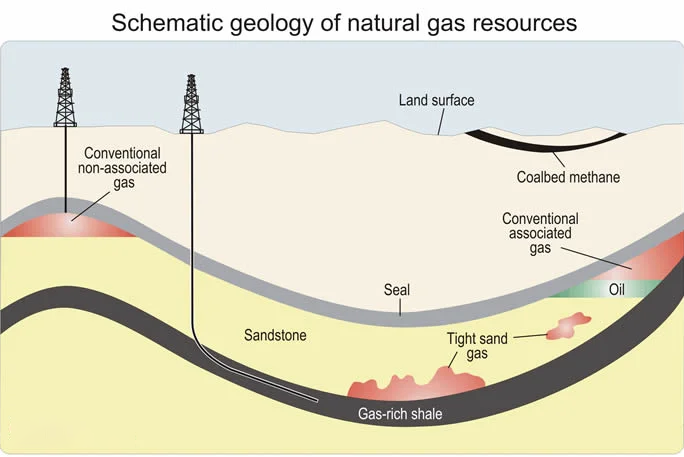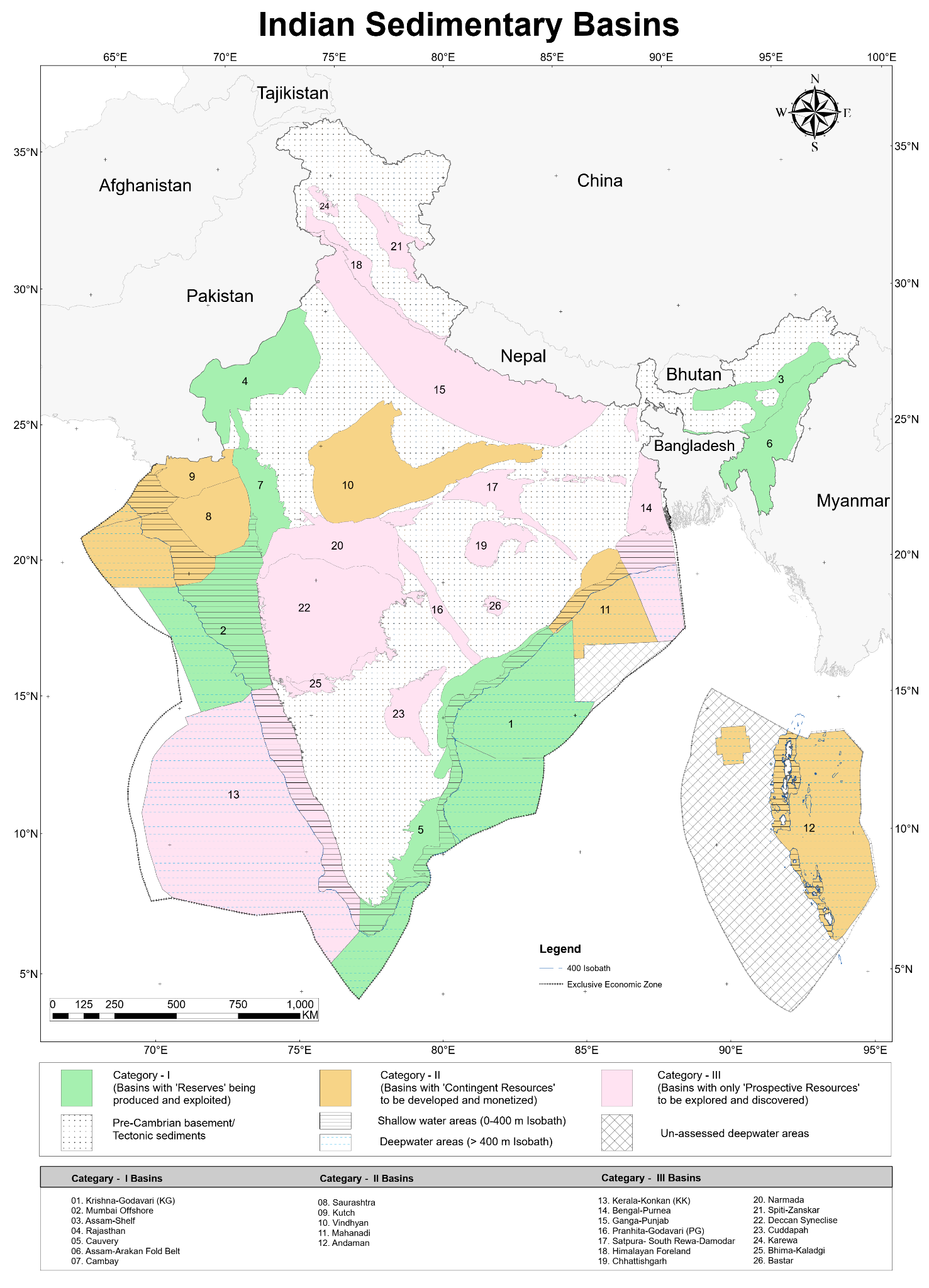Hydrocarbons Exploration and Extraction | 22 Apr 2024
For Prelims: Hydrocarbons, Hydrocarbon Exploration, Hydrocarbon Licensing Policy, Open Acreage Licensing Programme (OALP).
For Mains: The geological processes, extraction methods, and environmental impact of hydrocarbon extraction, Drawbacks of the New Exploration Licensing Policy (NELP), Hydrocarbon Exploration and Licensing Policy (HELP): Functions, Challenges, Advantages.
Why in News?
The two Industrial Revolutions were triggered by humanity's discovery of how to extract hydrocarbons. These hydrocarbons powered large engines, leading to contamination of the air, water, and atmosphere, and ultimately contributing to global warming.
- In light of escalating global warming, it's crucial for the world to consider less harmful ways of utilising hydrocarbons.
What are Hydrocarbons and their Storage?
- About:
- Hydrocarbons are organic compounds made up of Hydrogen and Carbon. While the carbon atoms create the compound’s framework, the hydrogen atoms attach to them in a variety of different configurations.
- Hydrocarbon Exploration is the search for deposits of hydrocarbons, such as petroleum and natural gas, in the Earth’s crust. It’s also known as oil and gas exploration.
- Kerogens are the lumps of organic matter and they are the primary source of hydrocarbons in the rocky underground.
- Kerogen can be deposited from three possible sources as the remains of a lake (lacustrine), a larger marine ecosystem, or a terrestrial ecosystem.
- Rocks surrounding the kerogen can become warmer, more compactified over time, exerting forces on the kerogen that cause it to break down.
- Lacustrine kerogen yields waxy oils; marine kerogen, oil and gas; and terrestrial kerogen, light oils, gas, and coal.
- Types: Based on their structure and bonding, Hydrocarbons can be classified as:
- Alkanes (Saturated):
- Structure: Consists of single bonds between carbon atoms.
- General Formula: Cn H2n+2 . Examples: Methane (CH4) and ethane (C2H6).
- Properties: Non-reactive; used primarily as fuels.
- Alkenes (Unsaturated with Double Bonds):
- Structure: Contain at least one double bond between carbon atoms.
- General Formula: Cn H2n . Examples: Ethylene (C2H4) and propylene (C3H6).
- Properties: More reactive than alkanes due to the double bond; used in chemical synthesis and as a precursor for plastics.
- Alkynes (Unsaturated with Triple Bonds):
- Structure: Contain at least one triple bond between carbon atoms.
- General Formula: Cn H2n−2
- Examples: Acetylene (C2H2).
- Properties: Extremely reactive; used in welding (oxy-acetylene torches) and as a chemical building block.
- Aromatic Hydrocarbons (Arenes):
- Structure: Contain rings of carbon atoms with alternating double bonds (aromatic rings).
- Examples: Benzene (C6H6) and toluene (C7H8).
- Properties: Stable due to their aromatic rings; used in the manufacture of dyes, detergents, and explosives.
- Alkanes (Saturated):
- Formation and Storage:
- Hydrocarbons occur naturally in plants, trees, and fossil fuels. Such compounds serve as the primary components of petroleum and natural gas and can be utilised in a wide range of different applications, such as fuels, and the production of plastics.
- Crude Oil and Natural gas are found under Sedimentary Rocks.
- These reservoirs are created when a more resistant rock type overlays a less resistant one, in effect creating a lid that causes hydrocarbons to accumulate below it.
- Their formation takes place over millions of years. The process of formation is as follows:
- The dead plants and animals get buried underground providing the carbon content for the hydrocarbons to be formed.
- Eventually a layer of mud settles over the buried debris, and mud gets converted to rock.
- Intense heat and pressure changes transform this debris into fossil fuels. I.E. crude oil and natural gas.
- The absence of oxygen and air is an important requisite for the formation.
- If the rock is impervious the crude oil remains locked under the sedimentary rock.
- Natural gas being less dense floats over the Crude oil.
Globally Top Oil Producers and Consumers Country:
- The top 5 Oil Producers and share of total world oil production
| Country | Share of world total |
| United States | 22% |
| Saudi Arabia | 11% |
| Russia | 11% |
| Canada | 6% |
| China | 5% |
- The top 5 Oil Consumers and share of total world oil consumption
| Country | Share of world total |
| United States | 20% |
| China | 15% |
| India | 5% |
| Russia | 4% |
| Saudi Arabia | 4% |
How are Hydrocarbons Accessed and Extracted?
- Accessing Hydrocarbons:
- Creating a Production Well: The first task is to create a production well, the principal hole through which the reservoir will be drained to the surface. Its location is chosen to maximise the amount of drainage.
- The well is created with a drilling machine.
- Casing and Cementing: Steel casings narrower than the hole are lowered into the well and surrounded by cement slurry to protect against cave-ins and prevent fluid intrusion.
- Drilling fluid, circulated around the drill bit, aids in cooling and removing rock cuttings.
- Blowout Prevention: The pressure at which the drilling fluid is delivered has to be carefully controlled otherwise it could force the hydrocarbons in the source rock to rush out and erupt on the surface like a volcano of oil.
- Mud-logging: It is the process of recording the rock cuttings by depth and studying their properties.
- Drilling: It is done by drilling rigs, which also come with generators and batteries to power various steps of the drilling process.
- These rigs can also be installed offshore, to boost their stability and aid extraction through the water column.
- Creating a Production Well: The first task is to create a production well, the principal hole through which the reservoir will be drained to the surface. Its location is chosen to maximise the amount of drainage.
- Extracting Hydrocarbons:
- Completing Stage: It is the process of draining out the hydrocarbons by removing the drill string from the borehole and punching small holes into the casing.
- Production Stage: Systems at the well’s head control the outflow of hydrocarbons using valves. Pump jacks are used to lift up hydrocarbons from the bottom of a well when the pressure difference is too low to bring the hydrocarbons to the surface.
- Depending on the methods required to maintain production it can be split into three phases: primary, secondary, and tertiary,.
- Primary phase relies on natural processes, like pressure differences between the reservoir and the well.
- Secondary phase involves inducing artificial pressure in the rock to maintain the differential.
- Tertiary phase uses enhanced recovery methods like steam injection to extract remaining hydrocarbons.
- Well Plugging and Decommissioning:
- Well extraction doesn't require full depletion; it's stopped when it is no longer profitable. Abandoned wells must be plugged to prevent hydrocarbon and gas escape.
- Decommissioning, the permanent sealing of a well, is costly and often not financially viable for operators.
Sedimentary Basins in India:
- There are 26 sedimentary basins in India, covering a total area of 3.4 million square kilometres.
- Of the total sedimentary area, 49% of total area is located onland, 12% in shallow water and 39% in the deepwater area.
- These basins are divided into three categories based on maturity of hydrocarbon resources as under:
- Category-I: Basins, which have reserves and are already producing.
- Category-II: Basins, which have contingent resources pending commercial production.
- Category-III Basins, which have prospective resources awaiting discovery.
Policies Related to Hydrocarbons Extraction in India:
- Hydrocarbon Exploration and Licensing Policy (HELP) was approved by government as an exploration and production policy that replaced the New Exploration Licensing Policy (NELP).
- The objective of the policy is to enhance domestic oil and gas production by intensifying exploration activity and investment.
- The new policy promises simpler rules, tax breaks, pricing and marketing freedom and is part of a government strategy to double oil and gas output by 2022-23.
- The policy is also aimed at enhancing transparency and reducing administrative discretion.
- HELP marks the biggest transition from an era of government control to government support for upstream E&P in India. Open Acerage Licensing Programme (OLAP) removes restrictions on exploration by giving companies both the data and the discretion to explore areas of their choice.
|
Drishti Mains Question: Q. Hydrocarbons play an important role in constituting the energy security of a country. But over dependence on energy imports can be a challenge to the energy security of India. In this context, discuss the initiatives that have been taken to cut down crude oil imports. |
UPSC Civil Services Examination, Previous Year Question (PYQ)
Prelims:
Q. The term ‘West Texas Intermediate’, sometimes found in news, refers to a grade of (2020)
(a) Crude oil
(b) Bullion
(c) Rare earth elements
(d) Uranium
Answer: (a)
Q. According to India’s National Policy on Biofuels, which of the following can be used as raw materials for the production of biofuels? (2020)
- Cassava
- Damaged wheat grains
- Groundnut seeds
- Horse gram
- Rotten potatoes
- Sugar beet
Select the correct answer using the code given below:
(a) 1, 2, 5 and 6 only
(b) 1, 3, 4 and 6 only
(c) 2, 3, 4 and 5 only
(d) 1, 2, 3, 4, 5 and 6
Ans: (a)
Mains:
Q. Access to affordable, reliable, sustainable and modern energy is the sine qua non to achieve Sustainable Development Goals (SDGs). Comment on the progress made in India in this regard. (2018)


